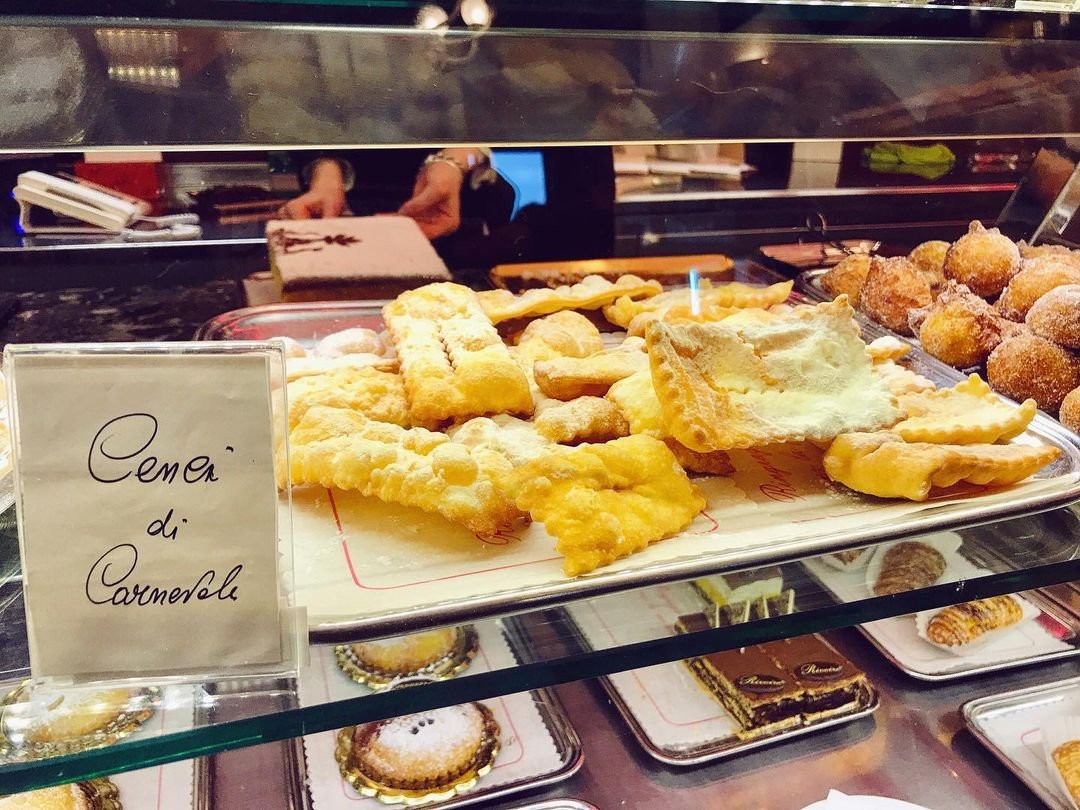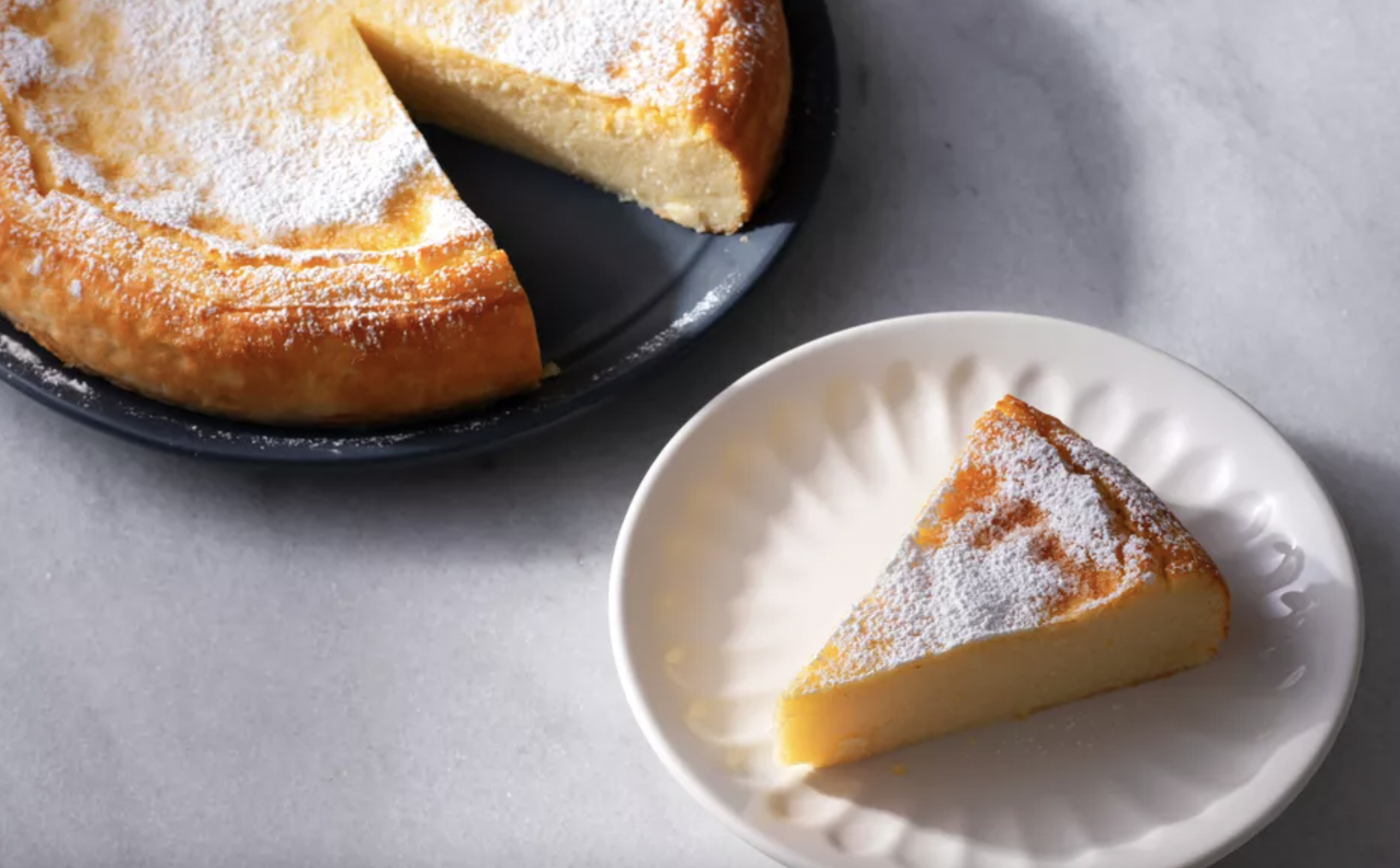Cenci also called "chiacchiere"- fried "rags" of dough!
(updated February 2022)
In Italy, the hottest party of the year happens to be in the coldest months! This year, Carnival (or carnevale in Italiano) is from February 13th until March 1st 2022 in Venice- here is the link for Venice Carnival Guide. You can also find Carnival events around Tuscany, including Viareggio. There are many other more scenic beach towns in Tuscany such as Castiglioncello and islands like Elba, however Viareggio comes alive during Carnevale with mask and float parades- definitely worth a visit!
Usually about mid-January (at least in Florence) you start to see Carnival-themed food specialties pop up in bakeries around town.
(psssst! Interested in a culinary walk in Florence during Carnival? Book our Food Lover's Tour or Market Walk in Florence. We'll be tasting these treats at the bakeries and bottegas we visit on our specialty walks!)
How does Carnival relate to seasonal treats in Italy? Well, Carnevale is the party leading up to lent. During lent, rich foods containing fat, sugar and meat were big no-nos so these luxuries were consumed in gluttonous glory up until lent commenced. The big party that most are familiar with is Mardi Gras (Fat Tuesday, Shrove Tuesday) and indulgence in worldly pleasures was allowed until Ash Wednesday when lent commences.
Carnival is derivative from latin meaning "farewell to meat!" (Carne: meat, vale from levare meaning "to remove") and the tradition of celebrating in Venice dates back to 1162 after defeating Patriarch of Aquileia when the victory was celebrated around Shrove Tuesday and involved ridiculous activities such as pig and bull slaughtering in Venice's Piazza San Marco, where today the most lively carnival festivities still take place (add some masks and minus slaughtered animals!)
Since in Italy, a tradition and a party would be nothing without food- of course there are some foods that are made and brim local shops exclusively for Carnevale.
Here is our guide to the most common, must-eat foods in Florence during Carnival!
Chiacchiere. Photo: Coral Sisk.
Cenci or Chiacchiere
These slices of fried dough have many names. In Naples, they’re called Chiacchiere. In Tuscany, Cenci (literally rags). Elsewhere they’re bugie (which means “lies!’), frappole, galani, frittole, and crostoli.
Their origins back to ancient Roman times. The Romans used to make sweets called “frictilia” – with eggs and flour, fried in lard – to celebrate the Saturnalia, the ancient feast of the god Saturn, the equivalent of today’s Carnival. Frictilia was a simple and cheap sweet made in big quantities to be distributed to crowds celebrating in the streets.
It was considered the sweet of the poor because only a few ingredients were needed. To make it more appealing, people have invented a lot of variations over time and nowadays, every region has its own recipe.
These days, they are the holy trinity of goodness: fried full fat, a tinge of savory crunch and happily sweet. They are best when freshly fried of course, but surprisingly retain their flavor even after in bakery cases for a bit.
Frittelle di Riso. Photo: Coral Sisk.
Frittelle di Riso
Imagine sweet, luscious mouth-full rice pudding. Then imagine that rolled up, fried and immersed in sugar, letting the heat from the fried balls amalgamate the sugar to stick so sweetly to produce a pure fat, sugar and carb chunk of gluttonous heaven. THAT is what a frittelle di riso is. Sometimes, they go into the depths of bliss and inject custard cream or chocolatey Nutella. These sweets are also bite-size, so you can feel like they are just a small snack.
In Tuscany, these fritters are famous not just at Carnevale, but also Father’s Day, which is on March 19th. St. Joseph (a.k.a Jesus’ dad) is also the patron saint of friers, so it seems an auspicious day to be frying up a batch of these sweet, plump fritters for your papà.
Like anything deep fried, these are best eaten while still hot and crisp, so don’t save them to share! Have a go at making them at home with this recipe with loads of curious facts and tales.
Schiacciata alla Fiorentina in Florence
Schiacciata alla Fiorentina
While not fried like the last 2, la schiacciata alla fiorentina is a sweet flatcake extremely traditional to Florence, made with a tinge of citrus and sometimes lathered with chantilly cream in the middle. It is also doused in powdered sugar and in Florence, you find the fleur de lis "giglio" crest of Florence etched in with powdered cacao. Here is another recipe- quite easy to make in respect to frying things!
This yeasted cake has long been a tradition of Carnival season and is a centuries-old recipe of peasant origins. It’s easy to confuse with Florence's savory salt- and olive oil-drenched focaccia or flatbread which is also called schiacciata. That’s not a coincidence since the original version of this cake was more of a bread made with ciccioli - pieces of deep fried pork fat. In fact, this variation is still prepared in the Maremma - a southern region of Tuscany.
Berlingozzo. Photo: Visit Tuscany.
Berlingozzo
Berlingozzo is a humble, plain cake similar to a pound cake but a little drier and baked in the form of a ring. Its roots can be traced back to the time of Cosimo de Medici and its name comes from a Tuscan word with German origins, berlingaccio, which means Fat Thursday. The Tuscans even have a verb, berlingare, which roughly means to have fun at the table – which is precisely what is called for during carnival time.
Traditionally, it’s scented with aniseed (or often, lemon or orange rind) and you’ll most commonly find it in Lamporecchio, near Pistoia, which is its hometown! It’s market fare and almost always enjoyed with an afternoon caffe.
Frittelle di mele. Photo: Coral Sisk.
Frittelle di mele
Yet another fried treat. Cards on the table, it ain’t Carnevale if something isn’t bubbling in a deep fryer. These apple fritters are popular throughout Northern Italy. In Alto Adige, they're a typical winter snack, eaten hot or cold, loved by children and adults alike, and even served as a side dish to pork and roasts.
They’re very similar to pancakes, but instead of fluffy doughy inside, it’s an apple slice. Germany has basically the same pastry, which it calls Apfelküchle or sliced apples dipped in batter and fried to a golden brown color. As for who invented it? It’s a chicken and the egg scenario between the close neighbors.
Migliaccio. Photo: The Spruce Eats.
Migliaccio
Our last Carnevale treat is not Tuscan-specific, but it’s a favorite Italy-wide. Migliaccio is a crustless Neapolitan semolina and lemon cake made rich and moist with ricotta.
The original recipe goes back to Medieval times, when miglio (millet flour) was the main ingredient. In medieval Italy, the cakes were prepared not as a dessert but as a dietary mainstay. Leftover millet mush was mixed, often, with rich pig’s blood. The rustic mixture was poured into a pan and hearth-baked to create a filling, wholesome snack.
These days it’s much less daunting with a flavor that sits somewhere between a North American cheesecake and a thick pudding. Think moist, creamy and packed with vanilla.
Don't particularly have the patience to bake or want to compare your baked version to the stuff they make in Italy?
Visit these bakeries in Florence for Carnival sweets
Pasticceria Nencioni- This pastry shop has a great selection of Italian regional baked goods, savory pastries, cakes and petit bites of sweets. They have a really great coffee bar and the service is jovial- a great spot in Sant'Ambrogio and they have Schiacciata alla Fiorentina welcoming the window display. Pasticceria Nencioni Via Pietrapiana, 24/r Florence, Italy Web: http://www.pasticcerianencioni.com/
Antico Forno Giglio- For the longest time, I've tried to keep this bakery under wraps. But its so good, I can't hold out any longer. It's located just few minutes walk from the Sant'Ambrogio quarter in the zone Beccaria. It's a great area to stroll around in general as there are tons of shops, local cafes and foodie gems like this forno bakery. Be aware that its almost always packed so take a number and be patient- these guys are totally worth it. Address: Antico Forno Giglio: Via Vincenzo Gioberti, 151R Florence, Italy
Pasticceria Giorgio- Located a bit off the map from the center in the Soffiano suburb, but according to the city's most respected food lovers like Girl in Florence says this bakery is worth the trek. Plus, for those wanting a slice of local life it wouldn't hurt taking a taxi or driving out to this Florentine institution for traditional baked goods for more of a sweet tooth immersion outside the center. Address: Via Duccio di Buoninsegna 36 Web: http://www.pasticceriagiorgio.it/
Caffe Neri- Like Giorgio, Neri is a bakery icon. The original Caffe Neri is also a bit on the outskirts in the Sesto Fiorentino suburb definitely worth the voyage especially if visiting Medici villas is on your bucket list. Caffe Neri's claim to fame is Simone Bellesi- head pastry chef whose Schiacciata alla Fiorentina has won awards in various bake-offs and is the official provider of dolci to the Fiorentina football (soccer) team. This is THE place if any to have a true Schiacciata alla Fiorentina. The best part is that you can usually find this sweet year round since it's in such high demand. Address: Caffe Neri C/O Villa Donatello Via Gramsci 809, Sesto Fiorentino (FI) Web: http://www.caffeneri.it/
Rivoire- Located in Piazza della Signoria, I consistently recommend this cafe for coffee and sweets smack dab in the center. Their frittelle di riso are irresistible and their coffee is always on point. Tip: Unless you want to sit-down and pay a whopping service fee, I suggest to enjoy a couple frittelle and a coffee at the bar standing and soak in the old-fashioned, yet classy vibe that fills the cafe thanks to the charming barmen. No matter how "touristy", Rivoire will always be in my book. It was one of the first places that served the Negroni for Camillo's sake! Address: Piazza della Signoria, 5 Web: http://www.rivoire.it/













